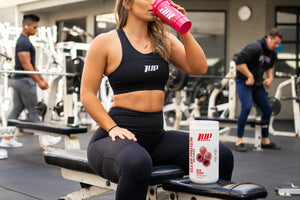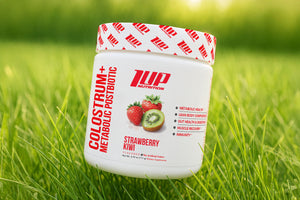The warm up is an important part of every training session, regardless if it’s resistance training, cardio, or circuit training.
It helps increase core temperature, preps the joints and muscles, and fires up the central nervous system to help your body work at peak output during the training session.
But, everyone tends to warm up a bit differently.
Some hop on a cardio machine for 5-10 minutes and work up a sweat. Others do bodyweight circuits. Still others do a series of stretches and mobility drills. And, believe it or not, some people forego the warm up entirely and jump straight into their workout the moment they enter the gym.
Regardless of how you warm up, today we’re going to discuss the do’s and don’ts of stretching as a warmup since a significant portion of the gym-going crowd does it in some form or another.
Let’s get started by first discussing the differences between the two different types of stretching commonly included in warmups.
Static Stretching vs Dynamic Stretching
Static stretching is the most common type of stretching. If you’ve been physically active for the majority of your life, chances are that you’ve done lots of static stretching during your time training, competing, or playing recreational sports.
Static stretching involves holding a stretch for a certain period of time, typically 15-60 seconds, and is repeated 2–4 times. It’s believed that static stretching helps “lengthen” a muscle, and while that’s not exactly true (you can’t actually increase the overall length of a muscle by stretching), research indicates that you can increase your tolerance to stretching when using the static variety.[1]
Dynamic stretching is believed to be more “functional” since it involves sports-specific movements and has athletes going through a greater range of motion compared to static stretching.
Dynamic stretching movements are usually repeated between 10-12 times before moving into another movement.
The main reason why coaches and trainers have began to favor dynamic stretching in lieu of static stretching as a warmup is due to some research indicating that performing intense static stretches for longer than 60 seconds and then immediately going into a resistance-training exercise can adversely affect strength and power output.[2]
Additionally, static stretching (if done improperly) can torque joints and ligaments or irritate nerves, leading to pain or reducing joint stability.
Smarter Stretching Swaps
Do This: Band-Assisted Straight-Leg Lowering
Band-assisted straight-leg lowering is performed while laying on your back, which helps prevent straining the low back, which many people typically due during the more traditional seated hamstring stretch.
As you raise and lower your leg, make sure to brace your core and push your lower back into the floor while exhaling to fully activate your core.
Not That: Seated Hamstring Stretch
We’ve all performed this exercise, either before an intense leg day or before hitting the road and going for a jog.
The issue with this exercise is that most people perform it incorrectly and instead of keeping their chest up, they let it cave in as they try to touch their face to their knees. What this does is lower the stretch on the hamstrings and increase tension in the lower back.
Do This: Side-Lying Windmill
The side-lying windmill is a phenomenal warm up movement works thoracic extension and glenohumeral external rotation/mobility. It’s also phenomenal for stretching the pecs too! For those who are desk-bound at work most of the day, this movement also helps combat the hunched-over posture.
To perform the side-lying windmill, lie on your left side and sweep your right arm around like a windmill. Make sure your eyes follow your hand throughout the entire range of motion. Make sure to follow your hand with your eyes throughout the entire movement.
Not That: Lower Back Twist
The lower back twist is commonly used to help relieve low back tightness, one of the leading causes of disability.[3]
However, many individuals end up over-rotating on the exercise, inducing further (unwanted) stress on the lumbar vertebrae. Additionally, if you lack sufficient thoracic extension or shoulder mobility, you may not be able to perform the stretch properly, which could result in pain and/or injury.
Do This: Split-Stance Adductor Rockback
The split-stance adductor rockback is great for opening up the hips and groin while also activating the glutes. The gentle rocking motion also helps you gradually deepen your range of motion and increase the stretch as you oscillate back and forth, providing a superior means to opening up the lower body ahead of leg day.
Not That: Butterfly Stretch
The butterfly is another throwback to yesteryear where individuals sat with their feet pressed together and tried to drive their needs down to the ground, or force them down with their elbows (or the assistance of a partner).
Believing this would help loosen up the adductors, the reality is many people are too stiff to derive much benefit from the stretch when they’re not properly warmed up. Tightness in the adductors can lead to stress on the ligaments of the knees and hips.
Do This: Foam Rolling the Upper Back/Rear Delts
The easiest, most effective means to loosen up the rear delts and upper back musculature is to use a lacrosse ball and/or foam roller. If using a ball, you can stand with your back to a wall and roll back and forth across the tight areas. When you find a tender spot, hold there and take several deep breaths until the tightness or “knot” relieves itself.
Not That: Crossbody Shoulder Stretch
Shoulder tightness can be caused by a number of things (too much pressing, not enough pulling, poor posture, etc.). The crossbody shoulder stretch is one of the most commonly performed exercises to help stretch the shoulders and alleviate the tightness.
However, this stretch focuses on lengthening the rear delts, not the front (anterior) delts, which is where most people are overly tight. Furthermore, cranking your arm across your body can also clamp down on many of the sensitive structures contained in the front of the shoulder, which can exacerbate shoulder aches.
Do This: Side-Lying Clamshell
The IT-band is the largest tendon in the body, and it runs along the outside of the thigh.
You’ll often see runners trying to stretch it by performing a standing stretch where one foot is crossed over the other.
However, the standing IT-band stretch really just stretches the muscles surrounding the IT band -- quads, hips, hamstrings.
A better alternative is to perform the side-lying clamshell.
What many individuals mistake for IT-band tightness is actually tightness in the tensor fasciae latae (TFL) muscle, which sits above the IT band. The cause of TFL tightness is due to it being overworked on account of weak glutes. Clamshells help strengthen the glutes, particularly the glute medius (a muscle notoriously weak in lifters).
Not That: Standing IT-Band Stretch
As we mentioned, the IT band is the largest tendon in the body, making it virtually impossible to stretch. The traditional IT-band stretch may help alleviate some tightness in the hips or glutes, but it’s not doing much of anything for the actual tightness you feel along the side of your leg or the weakness in the glute medius.
Takeaway
Static stretching can have a place in your training program, but it’s best suited to the cooldown, not the warm up.
Dynamic stretches increase mobility and prep your body for the intense work ahead.
In closing, keep these four points in mind:
- Opt for dynamic stretching in your warm ups instead of static stretching
- Dynamic stretching helps increase range of motion and preps the body for intense physical activity without impairing strength or power output.
- Key areas to focus on for dynamic stretches are the shoulders, hips, and lower back.
- There’s no need to overdo your dynamic stretches and use excessive ranges of motion, especially if you’re hypermobile, as that can result in pain or injury.
References
- Magnusson SP, Simonsen EB, Aagaard P, Sørensen H, Kjaer M. A mechanism for altered flexibility in human skeletal muscle [published correction appears in J Physiol (Lond) 1996 Dec 15;497(Pt 3):857]. J Physiol. 1996;497 ( Pt 1)(Pt 1):291-298. doi:10.1113/jphysiol.1996.sp021768
- McHugh MP, Cosgrave CH. To stretch or not to stretch: the role of stretching in injury prevention and performance.Scand J Med Sci Sports. 2010;20(2):169-181. doi:10.1111/j.1600-0838.2009.01058.x






